“Crime is my thing,” said photographer Weegee of his work. He was right when he boasted of having some 5,000 murders behind him, with exaggeration, captured with his camera on the streets of New York and with which he abundantly fed the tabloids between 1935 and 1945, to which he himself took his copies. However, this Ukrainian and Jewish immigrant had another side, opposite, little known and more humorous, which he showed from the end of the 1940s in what he called “photocaricatures”, deformed portraits of Hollywood stars and which “can be seen for the first time in Europe”, highlights Clément Chéroux, curator of the exhibition at the Mapfre Foundation, in Madrid, organized by the Henri Cartier-Bresson Foundation and which can be seen from this Thursday until January 5, 2025.
In the exhibition, titled Weegee. Autopsy of the show, with more than a hundred images, These two facets of the famous photojournalist converge: the one who ran through the mean streets to remove a corpse with its trail of blood and the one who showed Elizabeth Taylor with a comical face, as if he had placed her in front of a distorting fairground mirror. “He went from a direct style, of showing reality, in his first stage, to manipulated images that distorted reality. I don’t know of many examples of this in the history of photography,” Chéroux emphasizes.
The beginning of the exhibition gets straight to the point, with a succession of images of dead people, at a time when gangsters settled scores without any qualms or when an off-duty policeman killed a gunman. They are night shots, illuminated by the flash of the light bulbs that the cameras had. Images of strong backlighting, pure film noir. Although he also paid attention to details, such as a car accident in which he showed a wheel that stepped on the tip of a shoe.
On the opposite wall is a small series of the more than 1,500 portraits made by Usher Fellig (his real name), born in 1899. It is an exercise in narcissism in which we see a plump guy, with thick black hair, a somewhat mocking look and almost always with a cigar in his mouth. In one of them we see him from behind, with the trunk of his car open, which served as an office: with a typewriter and a small laboratory where he developed. He also kept shoes, socks and something to eat. In others, Weegee photographed himself inside a police van or behind bars. An example of his mischievous humor.
He had started out in the trade as a developer at a news agency. At that time he was not yet using his famous pseudonym, which he took from the English pronunciation of the word ouija (seed) why He boasted of being a “medium photographer,” capable of guessing where an event was going to take place and, sometimes, arriving before the police.
The reality was that Weegee had the police frequency on his car radio, lived across the street from a police station, drank with the officers, had contacts in hell (he knew mobsters like Lucky Luciano) and spent hours on end on the streets of the Big Apple. An extraordinary image is that of the rescue of a drowned ambulance driver from the waters of the river. In a high angle shot, with means that required careful thought for each shot, he managed to frame all the elements: the dead man, the police, the bow of the rescue boat and the car, from which the upper part emerges.
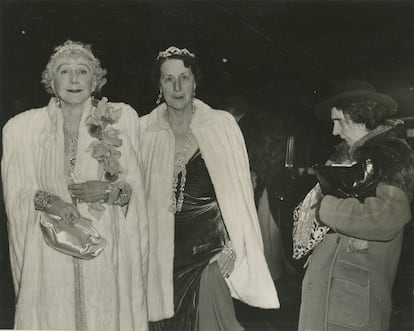
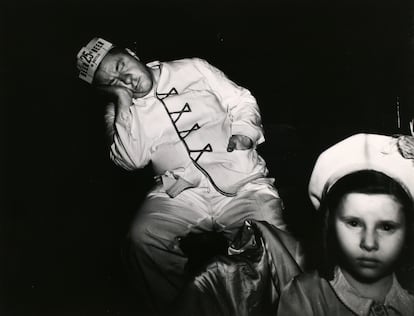

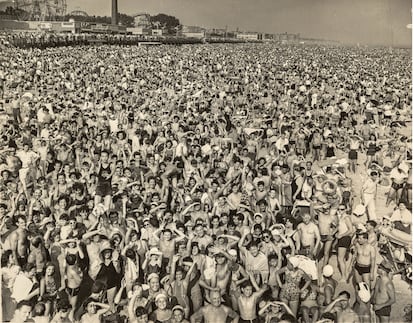
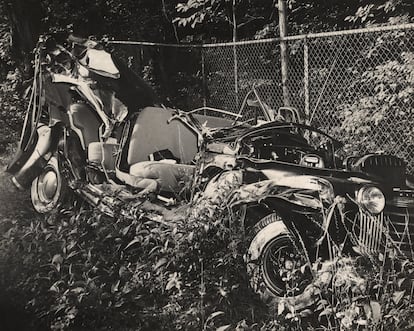
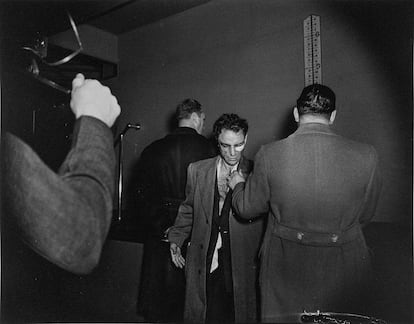
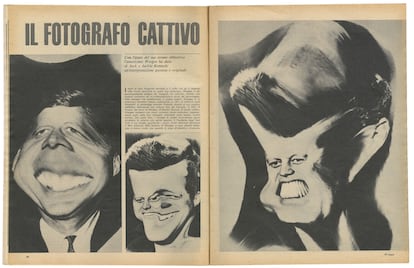
Before all that, Usher Fellig was a boy who arrived at the age of 10 with his mother and siblings in the United States, on Ellis Island, at the beginning of the 20th century on a ship packed with immigrants. It is an image that reminds us of the little Vito Andolini (later Vito Corleone) in The GodfatherThe subtle difference is that Corleone ordered the murders and Weegee photographed them. The father of the family had emigrated some time ago and was a street fruit vendor.
The young Usher, who was renamed Arthur to make him more American, left home early, lived in near poverty, slept in homeless shelters, on park benches… a stage that made him show his most human side as a photographer in his series on the most helpless in society, whom he portrayed with dignity, and which can also be seen in the exhibition.
Another of his series, which is now considered funny, is about suspects who cover their faces during their arrest, like the nurse who hides her face with her hands, suspected of murdering a baby, or the pair of mobsters who hide theirs with their hats inside a police van. Weegee was on the lookout and knew where to position himself.
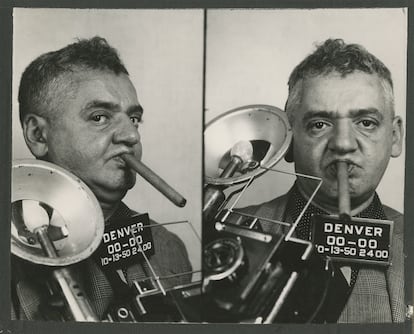
However, the photojournalist has also always been dogged by controversy, if he changed elements in crime scenes to achieve greater theatricality, as recounted in the film inspired by his life. The public eye (1992), starring Joe Pesci. “It’s clear that for him that ethical boundary fluctuated. There were cases where he did prepare some components,” the commissioner noted. The most glaring example is the photo that Weegee considered his favorite, The Criticismwhich shows two New York high society women, dressed in furs and bejeweled, arriving at an opera premiere, watched resentfully from a few inches away by another woman, who looks almost destitute. It was a staged photo. Weegee had taken her from the underworld and placed her next to the pair of ladies. It was his way of protesting social inequalities. “Sometimes he made small adjustments to the scene, but not to lie, but to show something representative,” concluded Chéroux.
Not for nothing did Weegee himself cynically say in an interview that the easiest part of his job was covering a murder: “The stiff will be lying there unable to get up or get temperamental, so I have plenty of time.”
However, he wanted to go beyond being considered a vulture looking for carrion. Aware that he lived in a new society, that of the spectacle, he began to include in his snapshots the photographers who portrayed the events and the people who came to look at them. The most significant was the one he titled Amphitheatre tickets for a murder, in reference to the numerous neighbors looking out of their windows.

In 1945 he published the book that made him famous, Naked City (The Naked City); World War II had ended and Weegee had “grown tired of dead gangsters in the gutter with their guts spilling out.” His crime photos had risen from the most sensationalist press to the MoMA. So he changed his surroundings, went to California and began to make his photocaricatures of Hollywood celebrities: Marilyn Monroe, Chaplin, Jackie Kennedy, Peter Sellers… all distorted with what he called “elastic lenses.” It was his way of laughing at the gods of cinema. “They sold like hotcakes,” he said. He returned to New York but this time to give lectures, publish books and sell his photocaricatures to the press. He died in New York in December 1968, at the age of 69, when his work had already been forgotten for some time.
At the end of the exhibition, returning once again to mass society, snapshots are shown of his fascination with crowds, on a beach in Coney Island, in Times Square or Chinatown… It was a different Weegee, very different from the one who explained his passion for photographing events before anyone else: “I was enchanted by the mystery of murder.”

